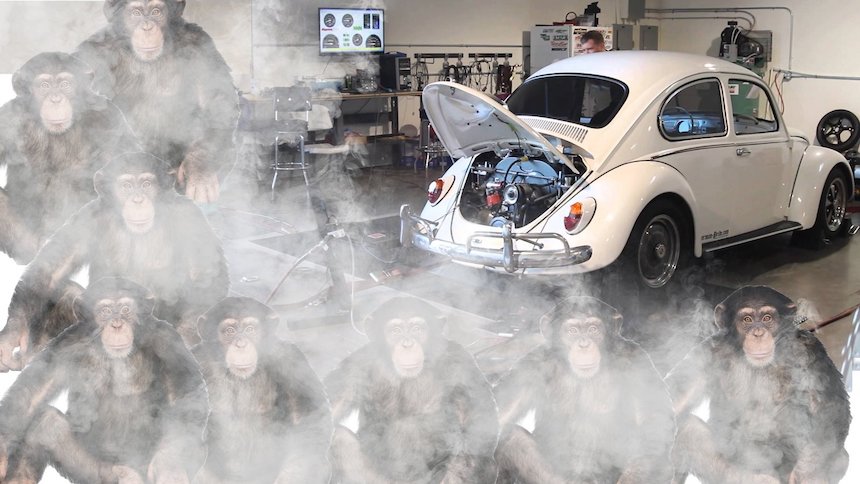
Volkswagen, the world’s largest carmaker, along with BMW and Daimler, funded experiments in which cynomolgus monkeys and humans breathed in car fumes for hours at a time to produce scientific research data showing that the pollutant load of nitric oxide car emissions from diesel motors had measurably decreased, thanks to modern cleaning technology.
We now know that the vehicles used in the research were manipulated to produce favorable diesel emissions.
In 2014, Albuquerque, New Mexico-based Lovelace Respiratory Research Institute (LRRI), on behalf of BMW, Daimler, and Volkswagen, all whom belonged to the European Research Group of Environment and Health in the Transport Sector (EUGT), a now defunct car lobby group, conducted the first round of tests by placing ten cynomolgus monkeys in small airtight chambers for four hours at a time, left to watch cartoons for entertainment as they breathed in diesel fumes from a late-model Volkswagen Beetle. The second round of tests involved the monkeys breathing in fumes from a 1999 Ford F-250 diesel, for the purposes of comparison against the Volkswagen Beetle — a modern vehicle with a more advanced filter technology. The monkeys were subsequently anaesthetised and intubated, so their blood could be examined for inflammatory markers, while their lungs were washed out and their bronchial tubes examined.
The human study, which few details are publicly available, were carried out on nineteen men and six women at Germany’s Aachen University Clinic and involved them breathing in varying concentrations of nitric oxide and later examined for sideeffects. The university wrote in a statement that the human study was to examine whether the exposure to nitric oxide at various concentrations below the previous legal limit would result in biological effects in healthy volunteers. “The study thus served to optimize job security, for example for truck drivers, vehicle mechanics and welders,” the statement read. “Extremely sensitive, non-invasive techniques were used to capture the biological response, in line with the best available methodology and based on years of development work.”
The results of the monkey and human experiments were presented to EUGT executives, but LRRI scientists along with Daimler and BMW representatives said they were unaware at the time that the Beetle provided by Volkswagen had been rigged to produce pollution levels that were far less harmful in the lab than on the road. Daimler and BMW further claimed to have little knowledge of the study. “We are appalled by the extent of the studies and their implementation. We condemn the experiments in the strongest terms. Even though Daimler did not have influence on the study’s design, we have launched a comprehensive investigation into the matter,” Daimler wrote in a statement on Sunday.
The research brings to light the depth that Volkswagen went to dismiss scientific research on the dangerous effects of diesel emissions. The New York Times reported that EUGT had commissioned multiple studies, including the monkey and human studies, to defend the use of diesel after the World Health Organization in 2012 classified diesel exhaust fumes as carcinogenic.
Since 2015, Volkswagen has been under federal scrutiny in the United States for the “dieselgate” scandal, in which the automaker installed software in about eleven million cars globally to manipulate emissions tests. The software enabled Volkswagen diesel cars to detect when an emissions test was underway, at which point, the cars’ full emissions control systems are turned on. During normal driving, the controls are automatically turned off, allowing cars to release as much as forty times the pollution allowed under the Clean Air Act. For dieselgate, Volkswagen has since pleaded guilty to federal fraud and conspiracy charges and agreed to pay more than $26 billion in fines.
On the monkey study, Jake McDonald, the LRRI scientists who oversaw the experiments, said in a sworn 2017 deposition that he did not know the Volkswagen Beetle used in the study was rigged, noting that the software did not interfere with the filter that reduced carcinogenic fine soot particles from the exhaust, a technology that has in fact improved significantly. The software, nevertheless, controlled and hid the amount of nitric oxide released during emissions testing. Legal proceedings show that in August 2016, Michael Spallek, director of EUGT, emailed LRRI on the need to publish results of the study. “The E.U.G.T. point of view is that it’s time to try to finalize the report and to present or discuss the problems of the study in a scientific way ASAP.” The email was sent almost a year after news of the Volkswagen dieselgate scandal became public. Despite Spallek’s urging to release the results of the study, LRRI scientists were unable to produce a clear finding.

